#coccidae
Photo
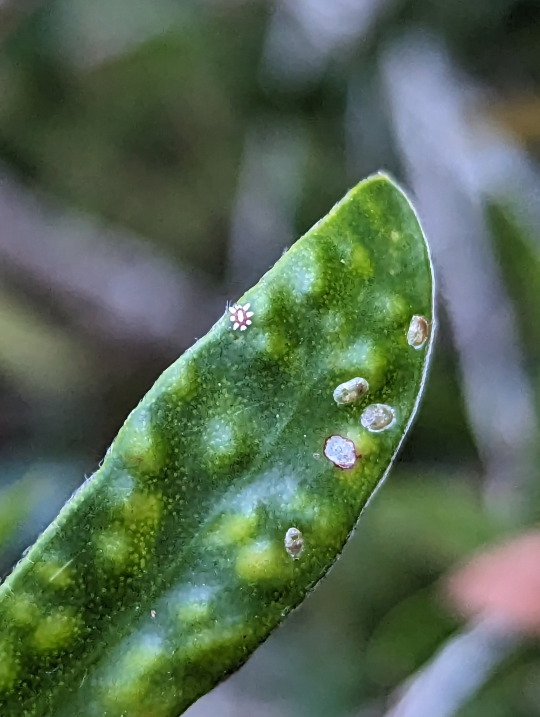

Small Starfish-like scale insects
I’m referring to the pointy ones, not the smooth round ones.
Unidentified, genus Ceroplastes
18/03/23
#Ceroplastes#Wax Scales#Hemiptera#Coccidae#Soft Scales#Coccoidea#Scale Insects#Sternorrhyncha#Plant-parasitic Hemipterans#Unidentified#invertblr#invertebrates#Arthropods#Arthropoda#bugs#bugblr#bugs tw#bug#insects#insecta#insectblr#insects tw#entomology
14 notes
·
View notes
Text
#1840 - Pulvinariella mesembryanthemi - Exotic Pigface Scale

AKA Iceplant Scale Insect
Spotted growing on the Pigface (Carpobrotus sp.) growing right down at the end of Woodman Point, Perth.
The actual insect is the brown thing - the rest is her cottony ovisac, which will contain hundreds of tiny crawlers when they hatch.
A Pulvinaria was a couch used by the Roman gods for religious rituals - presumably that’s related to the common name of cottony cushion scales. The species name refers to the preferred hostplants - Mesembryanthemum is one genus of flowering plants in the family Aizoaceae, and a close relative of Carpobrotus. The scale insect probably arrived in Australia from its native range in southern Africa, but it’s also made it to many other parts of world, especially where the Iceplant was introduced as a highway planting.
Other related scale insects also derive their binomials from their host plant -Pulvinaria dodonaeae is endemic to Australia and feeds on plants in the genus Dodonaea. Another introduced cottony soft scale found in Australia goes by the name of Pulvinaria hydrangeae.
2 notes
·
View notes
Photo

近所の生け垣にヒモワタカイガラムシがいた(6月1日)
0 notes
Photo
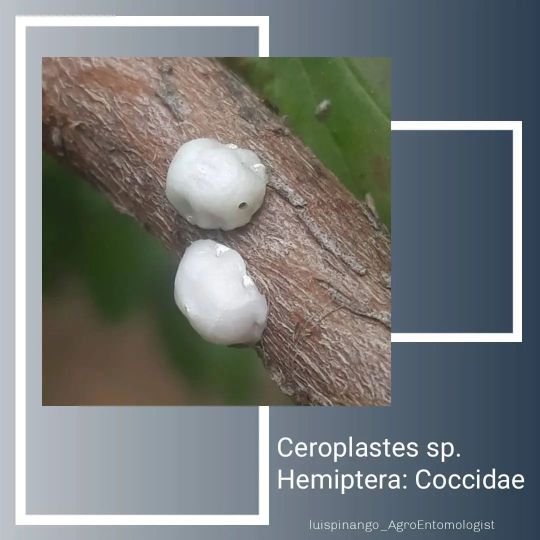
Esta escama es común en frutales y ornamentales. Se puede observar un orificio en el insecto que está en la parte superior, es un indicador que fue parasitado por una avispa. Eso se conoce como control biológico, cuando se emplean organismos vivos para bajar las poblaciones de las plagas en los cultivos. Fotografía cortesía de Jaime Carranza. Roraima, Brasil. Cultivo guayaba. #entomología #hymenoptera #entomology #entomologiaagricola #ipm #mip #controlbiologico #entomologist #arthopodos #ceroplastes #hemiptera #coccidae #guayaba #brasil #roraima # (en Valle de la Pascua, Estado Guarico) https://www.instagram.com/p/CfNFta3OYaf/?igshid=NGJjMDIxMWI=
#entomología#hymenoptera#entomology#entomologiaagricola#ipm#mip#controlbiologico#entomologist#arthopodos#ceroplastes#hemiptera#coccidae#guayaba#brasil#roraima
0 notes
Video
youtube
Yvette Introduces ToltrazurilShop.com | Toltrazuril | EPM & Coccida Trea...
0 notes
Text
Saissetia oleae pdf file
SAISSETIA OLEAE PDF FILE >>Download (Telecharger)
vk.cc/c7jKeU
SAISSETIA OLEAE PDF FILE >> Lire en ligne
bit.do/fSmfG
point noir sur branche olivier
traitement olivier savon noircochenille olivier
photo cochenille noire
Saissetia oleae. La cochenille noire de l'olivier effectue une seule génération par an. Comme pour tous les insectes piqueurs suceurs, les dégâts occa-. 1 mars 2022 — la cochenille du café (Saissetia coffeae) la cochenille noire (Saissetia oleae). Mode d'action et efficacité. C'est un prédateur des œufs de. de Y LAUDEHO · Cité 1fois — ces de la Cochenille noire, Saissetia oleae OLIV. (ARGY Species of Coccinellidae in olive groves of Greece. {à paraître). HAGEN {K.S.). 1962. de M CANARD · Cité 7fois — ETUDE D'UNE DEUXIEME GENERATION D'HIVER DE. SAISSETIA OLEAE OLIV. (HOM., COCCIDAE) EN ATTIQUE. (GRECE) ET DE SA REDUCTION PAR METAPHYCUS LOUNSBURYI. MOUCHE DE L'OLIVE Bactrocera oleae. C'est le principal ravageur de l'olivier. Les dégâts occasionnés par la larve peuvent remettre en cause la totalité de Text of La cochenille noire de l'olivier Saissetia oleae BERN. · PDF fileLa cochenille noire de · La cochenille noire de lolivierSaissetia oleae BERN.DE SAISSETIA OLEAE (OLIVIER). (IIOMOPTERA, COCCOIDEA, COCCIDAE). DANS LA REGION. DE MOULAY IDRISS DU ZERHOUN. M. EL HOMRITI er M. I ARAICHI *. de T Saliha · 2021 — Cycle biologique de la cochenille noire de l'olivier (Saissetia oleae) .……………22. Figure 14. Nous avons présenté le document comme suit :. gique contre la Cochenille noire, Saissetia oleae. Ce nouvel aspect de l' activité de Centre a fait l'objet d'un Avenant au Plan d'Opération.
https://www.tumblr.com/fomulawowe/698380247259824128/homdox-cat-feeder-notice-mode-demploi, https://www.tumblr.com/fomulawowe/698380247259824128/homdox-cat-feeder-notice-mode-demploi, https://www.tumblr.com/fomulawowe/698381070409793536/2004-explorer-service-manuel-mode-demploi, https://www.tumblr.com/fomulawowe/698381239672094720/asymptotes-notes-pdf-mode-demploi, https://www.tumblr.com/fomulawowe/698380609355169792/acs880-01-hardware-notice-mode-demploi.
0 notes
Text
A misty scale is a small, white, wingless insect that feeds on the sap of plants. It is a member of the family Coccidae and is closely related to the mealybug. The misty scale is native to Africa, but has been introduced to other parts of the world, including North America and Australia.
The misty scale is a serious pest of citrus trees and can also infest other fruit trees and ornamentals. The scale secretes a sticky substance that covers the leaves of the plant and inhibits photosynthesis. This can lead to leaf drop and fruit deformities. The misty scale is difficult to control and can cause extensive damage to crops.
1 note
·
View note
Photo

100 notes
·
View notes
Photo


Soft scale insect (Luzulaspis kinakikir)
Photo by H. Tanaka, D. Sasaki, and S. Kamitani
#new species described a few months ago :)#soft scale insect#scale insect#luzulaspis kinakikir#luzulaspis#coccidae#coccoidea#sternorrhyncha#hemiptera#paraneoptera#neoptera#pterygota#insecta#hexapoda#pancrustacea#arthropoda#ecdysozoa
52 notes
·
View notes
Text

#017: Scake
This is Scake ! Based on Scale insects and pancakes ==:)
These tiny bugs feed off of plants! by hugging stems and sucking all the sugars. This in turn makes them extremely sweet, so they're sought after by predators, unfortunately for them. Fortunately, Scake are VERY flat, and removing them from their host plant is virtually impossible, good for them! Another day for them to enjoy having a sweet tooth!
Here’s what they look like from the side!

25 notes
·
View notes
Note
Not to be disrespectful or rude or anything, (I love debates so you can really just ignore this if you don't want to answer lol) but I was talking more on the basis of evolution.
If the supply of food is not enough to survive on or there is too much competition, some animals, and even bugs, will be forced to switch to another form of food. Of course, the switch in diet would take sometimes thousands of years, it is still possible.
Although you are right in that moths may not be able to do this. Some herbivore's digestive systems are completely geared towards eating plant matter and getting as much nutrients from it as possible. If they can't get any nutrients from the meat, then they will die. This is also true for their immune system, as they would be unable to fight off bacteria that could be in the meat. (Of course, they're bugs and they wouldn't have the same immune or digestive system as mammals, so who knows.)
One interesting thing to note is that there actually are come species of moths that are at least partially carnivores, like the Calyptra eustrigata, who feeds off of the blood of many mammals, including humans.
There is also the Laetilia coccidivora, who as a caterpillar will actually feed on Coccidae eggs and young. There is also the Epipomponia nawai, who is actually a parasitic moth toward cicadas and plant hoppers. They will latch on and feast on the flesh under their cuticles until their ready to cocoon, in which they'll unlatch themselves from their host.
You'd actually be surprised by how many carnivorous caterpillars there are, like the Eupithecia caterpillars, who are ambush predators. I actually suggest looking into it, it's very fascinating.
(Also one last thing, I mentioned Unn because she is one of the main reasons there is even plant life in Hallownest. I kinda had the thought that that's where they would get most of their food, considering in it's prime, the tribe probably had a good few members, so Unn's plants would be like a godsend for them lol. I didn't mean to insinuate that they worshiped her, I should have worded it better)
Anyway I love some friendly debate, and I'm happy I could have this conversation. Of course you can still not agree with me, that's completely reasonable, the majority of moths are herbivores. I'm just saying that it's not out of the realm of possibility. I hope you don't mind my essay, I love moths and this was my perfect opportunity to go in a tangent about them. :)
Lmao don’t worry you’re not being rude or disrespectful at all!
That’s interesting to learn actually! I’m not actually a bug fan so I don’t know like - a lot about moths or any other bugs really. Ironic considering I like this bug game <w<
Again I personally just can’t see it myself - but you make really great points. I guess to me it’d be like - very specific moths that do it rather than the entire tribe itself? There’s nothing stopping moths who are based on those carnivorous types to be omnivorous moths, or just flat out carnivores! I just myself can’t see like, Seer or Thistlewind eating it yknow? To me it just feels a little off - maybe that’s because all I knew was the regular moths until now idk!
(And yeah don’t worry about the Unn point! The timelines whack so I have no idea if Radiance came first or Unn - so I just believe that whilst Unn’s presence was amazing for all the herbivores in Hallownest - they could survive without her.)
I hope I didn’t insinuate too much that it was out of the realm of possibility, because it absolutely is! Sometimes when somethings concrete in my mind I low-key project that a bit, so like again whilst I just can’t see myself writing about that possibility myself - it absolutely can be a possibility!
(Edit!)
Also wait I completely forgot to mention in both points that I 100% believe the moths built up farms outside the village to keep the food supply ample! So even if before Unn the plant supply wasn’t the best - they simply took what they had and cultivated it.
(Another Edit because I just had a thought after the fact. Also spelling corrections. It was 6AM when I answered ok-)
Nothing about the Hallownest Moth Tribe strikes me as hunters - which I think is the key detail about their diet. Scavengers perhaps - but it’s been (at least, from my personal interpretation of the lore) kind of apparent the moths never really partook in a lot of activities such as hunting or fighting. Most probably aren’t even that trained in self defence. They used Dreamshields as a protective manner. So yes, the evolution idea makes sense! But nothing strikes me that these moths ever hunted or scavenged for other foods.
#happy screms#i don’t mind the essay at all :)!#learning facts i never knew hell yeahhhhh#i like friendly debates too - some people really forget what a friendly debate is just to make their side seem the right one#i agree with you about like - a lot of your points it’s just really really hard for me to see it on the moths myself#you’re not wrong#it’s more a personal ‘i can’t see the moths doing this no matter how hard i try’#honestly i wished we learned more about the moths besides their gods and dream connection (which was vague anyway)#ik in the game the whole point is that their legacy and culture got wiped but still#sorry if i came off as real stubborn in my original points - i can be with something concrete in my brain
9 notes
·
View notes
Photo


Pink Wax Scales, a common pest.
These insects are responsible for the “Black Sooty Mold”, along with other parasitic Hemipteran insects.
Ceroplastes rubens
01/06/22
#Ceroplastes rubens#Pink Wax Scale#Ceroplastes#wax scales#scale insects#Ceroplastinae#Coccidae#Soft Scales#Coccoidea#Sternorrhyncha#Plant-parasitic Hemipterans#Hemiptera#true bugs#bugs#bugblr#bug#insectblr#Arthropods#Arthropoda#insects#insecta#insects tw#insect#entomology
13 notes
·
View notes
Text
Scale Insects
I found mealybugs on one of my plants at home and it prompted me to look at it under the microscope (in photo below). It was a mild infestation and there were mainly two sizes of these white insects. The photo below shows a female adult turned over.
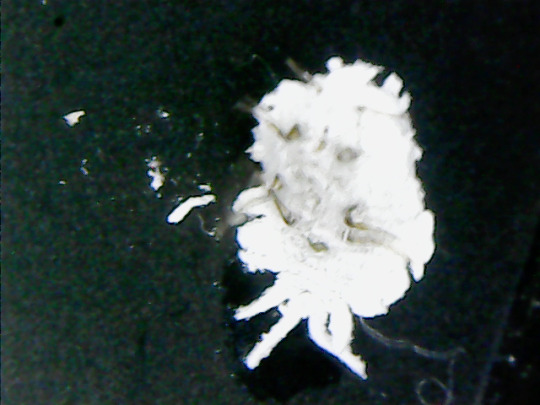
Background
Order: Hemiptera
Suborder: Sternorrhyncha
Superfamily: Coccoidea
~8,000 spp, > 30 families
Types of scale bugs include mealybugs (Pseudococcidae), armored scales (Diaspididae) and soft scales (Coccidae), lac insects (Kerriidae), and iceryines (Monophlebidae). They display sexual dimorphism, in which the adult females retain their nymph like features (a condition known as neotony), while the adult males possess two-wings (the other two has become vestigial) and lack functional mouthparts. Few scale insect species transmit viruses, notably on citruses, grapevines and pineapples. Natural enemies for biological control include entomopathogenic fungi, lady beetles (Coccinellidae), larval gall midges (Cecidomyiidae), wasp parasitoids (mainly Encyrtidae), and others.
Invasive species
International trade has proven to be a successful mode of dispersal considering the female’s sessile lifestyle. Reproduction modes (e.g. parthenogenesis and hermaphroditism) and a generalist diet (polyphagy) allow for further spread of scale insects.
Case studies
The Australian cottony-cushion scale, Icerya purchasi threatened the Californian citrus industry in the late nineteenth century. However, it has since been controlled by deliberate introduction of the coccinellid Rodolia cardinalis and the parasitic fly Cryptochetum iceryae (in photo below), both native to Australia.

The citrus mealybug, Planococcus citri, is a highly polyphagous and cosmopolitan species that causes damage to many crops. It is vector of virus A (GVA) and Leafroll Associated Virus 3 (GLRaV-3) (photo below) on grapevine, as well as of swollen-shoot virus disease of cacao in Ghana.

The cassava mealybug Phenacoccus manihoti was threatening the cassava crops of Africa. The release of the wasp Apoanagyrus lopezi (Hymenoptera: Encyrtidae) led to control of this pest. The introduction of parasitoid wasps on the mango mealy bug Rastrococcus invadens, and on the ink hibiscus mealybug (PHM), Maconellicoccus hirsutus were also successful. On the other hand, no successful control program for the cotton or solenopsis mealybug, Phenacoccus solenopsis, particularly in India and Pakistan, has been found. Similarly for the cycad scale, Aulacaspis yasumatsui (photo below), which is a major threat to native and ornamental cycads in the U.S.A., the Pacific, and Asia.


In the photo above: Mealy bug larvae (top) should not be mistaken for mealybugs (bottom) as they are good biocontrol agents.
https://www.researchgate.net/publication/259820840_Scale_Insects_Major_Pests_and_Management
1 note
·
View note
Text
🪲Hemiptera🪲
hemiptera tag
✨Families✨
coccidae
membracidae
plataspidae
0 notes
Text
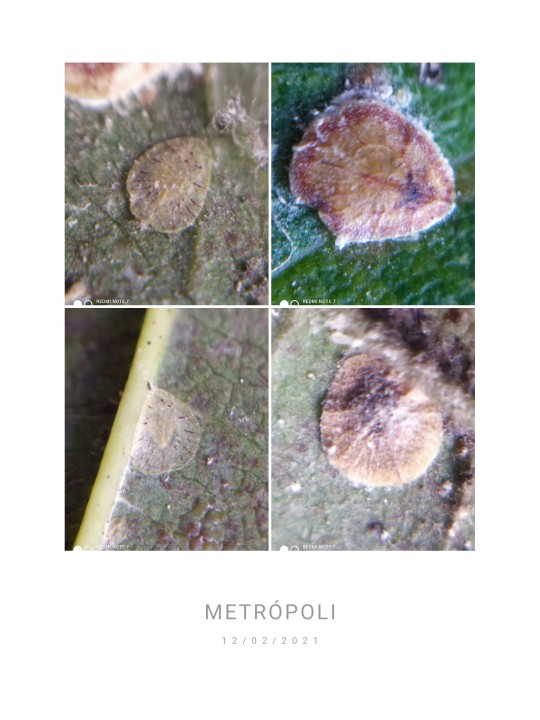
Escama verde (Coccus viridis Hemiptera: Coccidae) en aguacate 🥑 (Persea americana)
1 note
·
View note
Text
Silly Ways to Remember Different Parasite Eggs in Fecals
Caution: This is not an all-inclusive list and only includes popular parasite eggs in dogs and cats. Some of these memory tricks are truly ridiculous. You have been warned.
->Whipworms:

(image obtained from http://riverroadveterinary.com)
-This cutie looks like a football (with plugs/blunting at BOTH ENDS), and you commonly WHIP footballs around. Well that’s what I picture clearly I don’t know anything about football.
->Roundworm:

(image obtained from http://parasite.org.au)
- Besides this parasite looking obviously… ROUND, I think (and please forgive me here) that this looks like round chocolate pie.
->Hookworm:

(image obtained from princtonvet.com)
-These patooties look just like tapeworms in my opinion, and can be really hard to tell apart. How I do it: Hookworms looks like the eggs inside are cloudy and unclear, kinda if you put a HOOK (hookworm) in the water and swirled around. Therefore, cloudy parasite = hookworm.
->Tapeworm:

(image obtained from http://cal.vet.upenn.edu)
-In contrast to hookworms, this parasite (normally) looks clear and defined, like the edges and appearance of scotch TAPE.
-> Coccida:
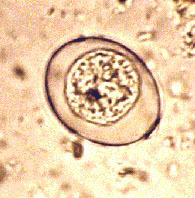
-Note: This little thing is SMALL. TINY! So some people can differentiate based on size alone since this guy is teeny one of the pack. I think this looks like a fried egg, which has two ggs, and coccida has two ccs. If that doesn’t work, fried eggs can come from cockatiels (as in coccida).
-> Giardia:

(image obtained from http://www.petsandparasites.org)
Not an egg, though weird little guy looks it is looking at you, like “GEE (as in GEEardia), does that thing have a face?”
Happy parasite hunting!
287 notes
·
View notes